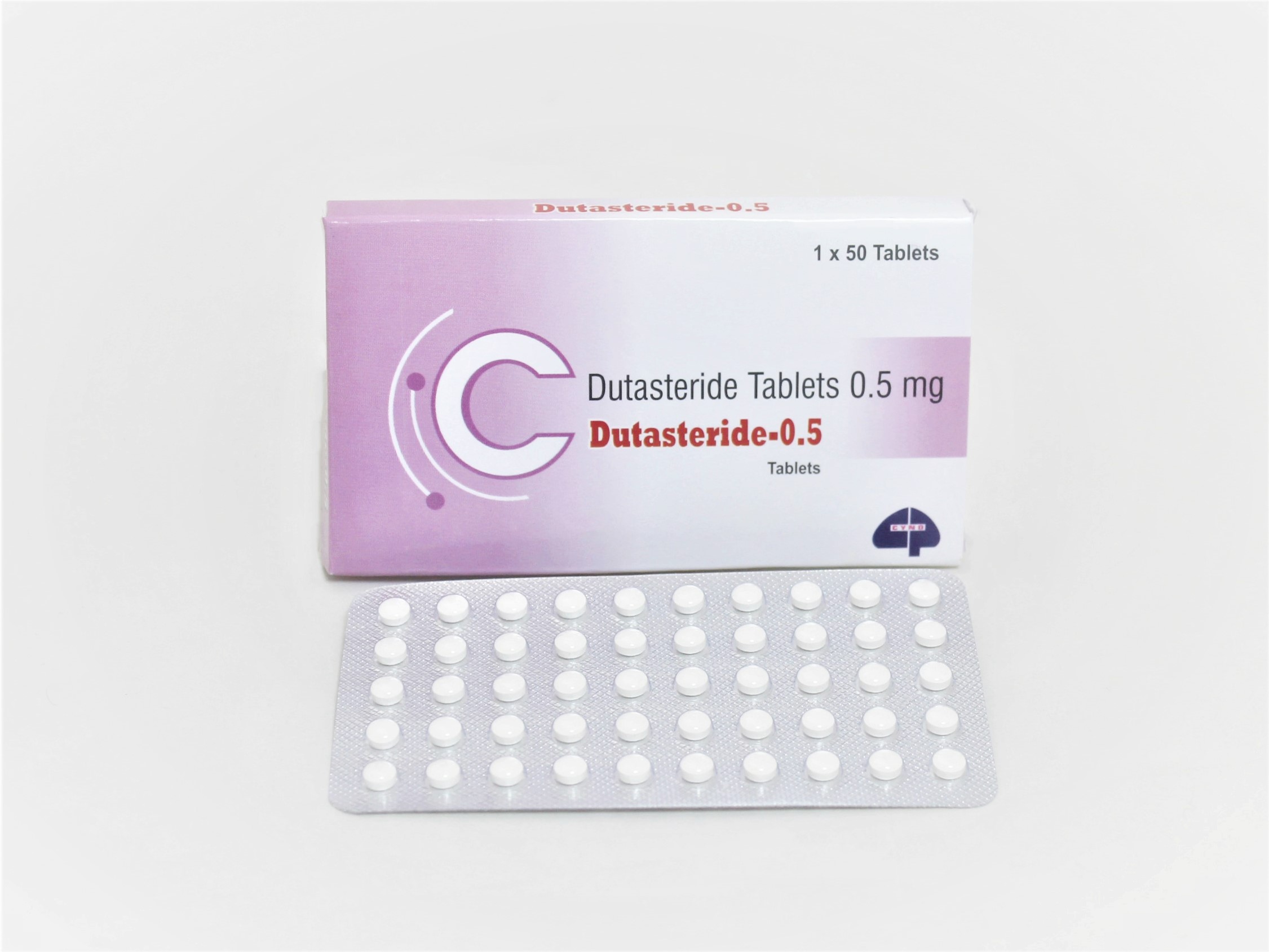Dutasteride- 0.5
Dutasteride-0.5 mg
Dutasteride is used to treat benign prostatic hyperplasia (BPH), which is also called enlarged prostate. When the prostate is enlarged, it can pinch or squeeze your urethra and make it harder for you to urinate.

Mechanism of action:
- The 5α-reductase is a nuclear-bound steroid intracellular enzyme primarily located in the prostatic stromal cell that converts androgen testosterone into the more active metabolite, 5α-dihydrotestosterone (DHT). DHT is considered to be the primary androgen playing a role in the early development and subsequent expansion of the prostate gland. It acts as a hormonal mediator for hyperplasia upon accumulation within the prostate gland. DHT exhibits a higher affinity to the androgen receptors in the prostate gland than testosterone 13 and by acting on the androgen receptors, modifying the DHT genes that are responsible for cell proliferation. Responsible for the synthesis of approximately one-third of circulating DHT, type I 5α-reductase is predominant in the sebaceous glands of most areas of the skin, including the scalp and liver. The type II 5a-reductase isozyme is mainly found in the prostate, semen vesicles, epididymides, and hair follicles as well as the liver, and is responsible for two-thirds of circulating HHT. Due to its dual inhibition of both isoenzymes of 5α-reductase, deutasteride causes near-complete suppression of DHT. A full-suppression of more than 90% of serum DHT is seen with dystasteride, compared to a 70% reduction in serum DHT levels caused by finasteride.
Pharmacokinetics:
- The oral bioavailability of dutasteride is approximately 60%. Food does not adversely affect the absorption of dystasteride. Peak plasma levels occur 2 to 3 hours after administration. Dutasteride levels in semen have been found to be 3 ng / ml, with no significant effect on DHT levels in sexual partners. The drug is metabolized extensively in the liver by CYP3A4. It has three major metabolites, including 6′-hydroxydeutasteride, 4′-hydroxideutasteride, and 1, 2-dihydrodutasteride; the former two are formed by CYP3A4, while the latter is not. All three metabolites are active; the 6′-hydroxydutasteride has the same potency as the 5α-reductase inhibitor for dutasteride, while the other two are less potent. Dutasteride has a very long terminal or elimination half-life of approximately 4 or 5 weeks. The elimination half-life of dutasteride increases in the elderly (170 hours for men 20–49 years, 300 hours for men> 70 years). No dose adjustment is necessary in the elderly nor in renal impairment. Due to its long elimination half-life, deutasteride remains in the body long after discontinuation and can be detected for up to 4 to 6 months. Unlike dutasteride, finasteride has a short terminal half-life of only 5 to 8 hours. Dutasteride is eliminated primarily in the feces (40%) in the form of metabolites. A small portion (5%) ends up unchanged in urine.
Pharmacodynamics:
- Dutasteride is a synthetic 4-azasteroid compound that selectively inhibits both type I and type II isoforms of steroid 5α-reductase, an intracellular enzyme that converts testosterone to 5α-dihydrotestosterone (DHT). Dutasteride works by decreasing the levels of circulating DHT. It was also shown to reduce the size of the prostate gland, improve urinary flow and reduce the symptoms of benign prostatic hyperplasia alone or in combination with tamsulosin. The effect of DHT deficiency by dutasteride is dose dependent with maximum effect within 1-2 weeks after initial administration.
Precautions:
- Before taking dutasteride, tell your doctor or pharmacist if you are allergic to it; Or for finasteride; Or if you have any other allergies. This product may contain inactive ingredients, which may cause allergies or other problems. Talk to your pharmacist for more details.
- Before using this medicine, tell your doctor or pharmacist your medical history.
- Before surgery, tell your doctor or dentist about all the products that you use (including prescription drugs, nonprescription drugs, and herbal products).
- When you are taking this medicine and do not donate blood for at least 6 months before taking it. This will prevent the possibility of your blood to the pregnant woman.
- This medicine should not be used in women, especially during pregnancy or breastfeeding. It can harm an unborn or lactating baby. Consult your doctor for more details.
Side effects:
- Serious side effects and their symptoms may include the following:
- Symptoms may include:
- Swelling of your face, tongue or throat
- Peeling skin
- prostate cancer. Symptoms may include:
- Increased prostate-specific antigen (PSA) concentrations
- Increased urination frequency
- Trouble starting urination
- Weak urine flow
- Painful / burning urination
- Trouble finding or maintaining erections
- Painful ejaculation
- Blood in your urine or semen
- Constant pain or stiffness in your lower back, hips or upper thighs
Dosage:
- The recommended dose of dutasteride is 0.5 mg once daily. Do not chew the medicine nor give it to pediatric patients.
Overdosage:
- There is no specific antidote to the excess of dutasteride as dutasteride is extremely safe and well tolerated. Research studies show that dutasteride is not fatal despite taking 100 times the normal dose. Treatment of dutasteride overdose should be based on symptoms and should be helpful. The long-term elimination half-life of dutasteride should be taken into account in the event of drug overdose. Dutasteride has been used in clinical studies, with doses of up to 40 mg / day for 6 months (10 times the therapeutic dose) and 6 mg (10 times the therapeutic dose) with no significant safety concerns or additional safety effects.
Warning:
- Prostate Cancer Warning: Dutasteride may increase your risk of prostate cancer. Your doctor will check if you have prostate cancer before performing a blood test for prostate-specific antigen (PSA). Dutasteride decreases PSA concentrations in your blood. If your PSA increases, your doctor may do further tests to check if you have prostate cancer.
- Pregnancy warning: If a woman is pregnant with a male child and accidentally swallows or touches the deutasteride in her body, the baby may be born with deformed sex organs. If your female partner becomes pregnant or is planning to become pregnant and her skin is exposed to a detastride capsule, she should immediately wash the area with soap and water.
- Blood donation warning: Do not donate blood for at least 6 months after stopping deutasteride. It helps a pregnant woman receiving blood to stop deutasteride.
Duration of action:
- Dutasteride has a very long terminal or elimination half-life of about 4 or 5 weeks. The elimination half-life of dutasteride increases in the elderly (170 hours for men 20–49 years, 300 hours for men> 70 years).
Drug – drug interactions:
- Despite any conclusive research studies, it is believed that 5α-reductase inhibitors such as dystasteride can inhibit the formation of neurosteroid metabolites such as allopregnanolone from progesterone and therefore reduce the psycho-cognitive effects of progesterone, especially if it is oral.
Adverse reactions:
- Dutasteride has been well tolerated in studies of both men and women overall, leading to minimal side effects. Adverse effects include headaches and gastrointestinal discomfort. Separate reports of menstrual changes, acne, and dizziness also exist. There is a small risk of gynecology (breast development or growth) in men. The risk of gynecomastia with 5α-reductase inhibitors is about 2.8%.
Pregnancy:
- Dutasteride should never be taken by a woman or child. If a woman comes into contact with it during pregnancy, then dutasteride can cause birth defects. Dutasteride capsules should not be controlled by a woman who is pregnant or may become pregnant.
Fertility:
- Vardenafil is not indicated for use by women. There are no studies of vardenafil in pregnant women. There are no fertility data available.
Contraindications:
- Dutasteride is contraindicated for use in women of childbearing ability and is therefore contraindicated during pregnancy. Dutasteride and other 5-alpha-reductase inhibitors inhibit the conversion of testosterone to DHT that can cause abnormalities in the external genitalia of the male fetus.
Storage:
- Store dutasteride capsules at room temperature between 68 ° F and 77 ° F (20 ° C and 25 ° C).
- Keep it away from high temperatures, as it may deform or fade. Do not use a dutasteride if the capsule is defective, discolored or leaking.
- Keep this medicine away from light.
- Do not store this medicine in moist or damp areas, such as bathrooms.
Breastfeeding:
- Dutasteride should never be used in breastfeeding women. It is not known whether dutasteride passes through breast milk.
